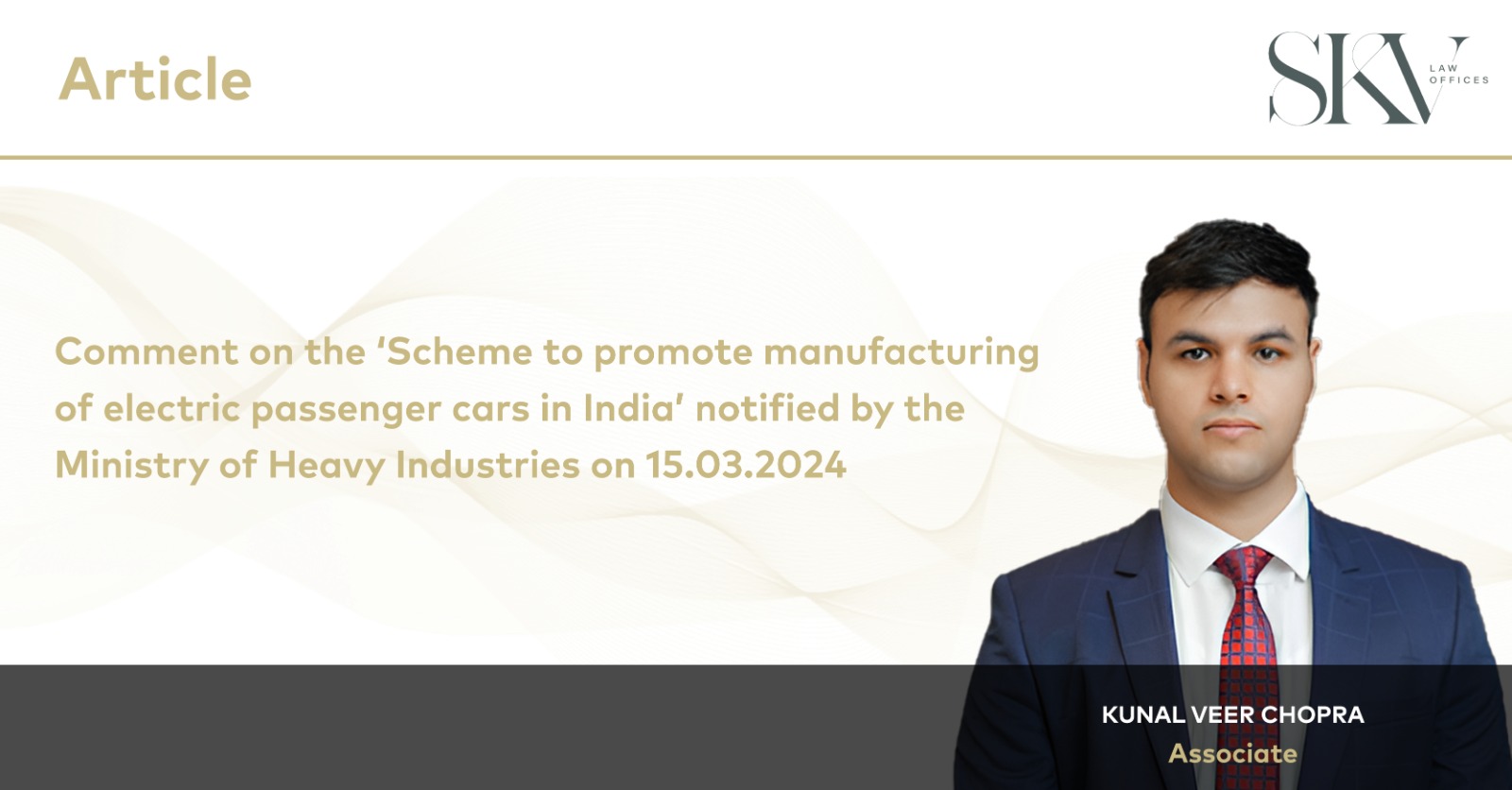Comment on the ‘Scheme to promote manufacturing of electric passenger cars in India’ notified by the Ministry of Heavy Industries on 15.03.2024
03.06.2024
Authored by: Kunal Veer Chopra, Associate
History of the Notifications
Introduction and Context:
- India is the world’s 3rd largest automobile market and one of the fastest-growing automotive sectors globally. The automotive market size is currently valued at Rs.12.5 lakh crore (USD 151 billion) and is projected to reach Rs.24.9 lakh crore (USD 300 billion) by 2030.
- The sector contributes over 7.1% to India’s GDP. The Indian government has recognized the need to transition from conventional internal combustion engine (ICE) vehicles to electric vehicles (EVs) to lead the global shift towards more efficient and environmentally friendly transportation technologies.
Previous Initiatives:
- The government has already launched several initiatives such as the Faster Adoption and Manufacturing of (Hybrid &) Electric Vehicles (FAME) scheme in 2015 and the Production Linked Incentive (PLI) schemes for Automobile and Automotive Components and for Advanced Chemistry Cell.
Current Scheme:
- This notification, dated 15.03.2024, introduces a new scheme to further promote the manufacturing of electric passenger cars (e-4W) in India. The scheme aims to make India a significant player in the global EV market, attract foreign investments, and boost the “Make in India” initiative.
Objectives of the Notification:
Promotion of EV Manufacturing:
- To encourage the establishment of manufacturing facilities for electric passenger cars in India by providing financial incentives and reducing import duties for initial periods.
- The scheme mandates a minimum investment of Rs.4,150 crore (USD 500 million) and achieving specified Domestic Value Addition (DVA) targets within a stipulated timeframe.
Financial Incentives and Duty Reductions:
- Approved applicants can import Completely Built Units (CBUs) of e-4W at a reduced customs duty of 15%, compared to the existing higher duty rates. This reduction is intended to lower the cost barrier for EV manufacturers setting up operations in India.
- The scheme outlines specific conditions and caps for the number of vehicles that can be imported at the reduced duty rate.
DVA Requirements:
- The scheme sets clear DVA milestones: 25% within three years and 50% within five years from the date of issuance of the approval letter.
- Compliance with these DVA requirements is crucial for continued eligibility under the scheme.
Employment and Economic Growth:
- By fostering a robust EV manufacturing ecosystem, the scheme aims to generate employment opportunities and stimulate economic growth.
- It aligns with India’s broader goals of becoming a manufacturing hub and enhancing its competitive edge in the global automotive industry.
Implementation and Monitoring:
- The scheme will be managed through a Project Management Agency (PMA), responsible for processing applications, verifying eligibility, and ensuring compliance with scheme conditions.
- A Scheme Sanctioning Committee (SSC) will oversee the overall implementation and address any obstacles that may arise.
Safeguards and Compliance:
- To maintain the integrity of the scheme, approved applicants must provide a bank guarantee equivalent to the total duty to be foregone or Rs.4,150 crore, whichever is higher.
- The scheme includes provisions to prevent dilution of shareholding, ensure related party transactions are conducted fairly, and incorporate an Integrity Compliance undertaking to uphold transparency and accountability.
Eligibility Criteria for Availing the Scheme Benefits
The eligibility criteria for availing benefits under the scheme are structured around three main pillars:
- Minimum global revenue requirements,
- Minimum investment commitments, and
- Minimum domestic value addition (DVA).
The first application window under the scheme is open for a period of 120 days from the date of notification, i.e., from 15.03.2024.
To be eligible, an applicant must meet the revenue criteria which necessitate that the applicant is a company or has a group entity incorporated in India engaged in automotive and/or manufacturing. Additionally, the company’s global group revenues from automotive manufacturing must be at least INR 10,000 crore (approximately USD 1.2 billion) per year, with global investment in fixed assets amounting to at least INR 3,000 crore (approximately USD 361 million). These requirements are intended to ensure the credibility and financial stability of the applicant.
Furthermore, the applicant must commit to a substantial minimum investment in India. Specifically, there must be a commitment to invest a minimum of INR 4,150 crore (approximately USD 500 million) in setting up manufacturing facilities over a three-year period. This investment must be backed by a bank guarantee, which will be invoked if the applicant fails to achieve the stipulated minimum investment and DVA criteria.
The scheme allows for investments in plant, machinery, charging infrastructure/equipment, and associated utilities, including buildings and utilities up to certain limits, as well as captive power and effluent treatment plants. However, expenditures on land (owned or leased) and second-hand plants and machinery are explicitly excluded.
The scheme also mandates specific domestic value addition (DVA) targets. Initially, the applicant must achieve a DVA of 25% within the first three years. This requirement is set to ensure that a significant portion of the manufacturing process adds value within the country. Subsequently, the DVA must be scaled to 50% within five years, promoting deeper integration of the manufacturing value chain in India.
In summary, to avail the benefits of the scheme, applicants must demonstrate significant global revenue, commit to substantial domestic investment, and achieve specified DVA targets. These criteria are designed to ensure the credibility of applicants, foster significant investment in India’s manufacturing sector, and promote substantial local value addition in the production of electric vehicles.


